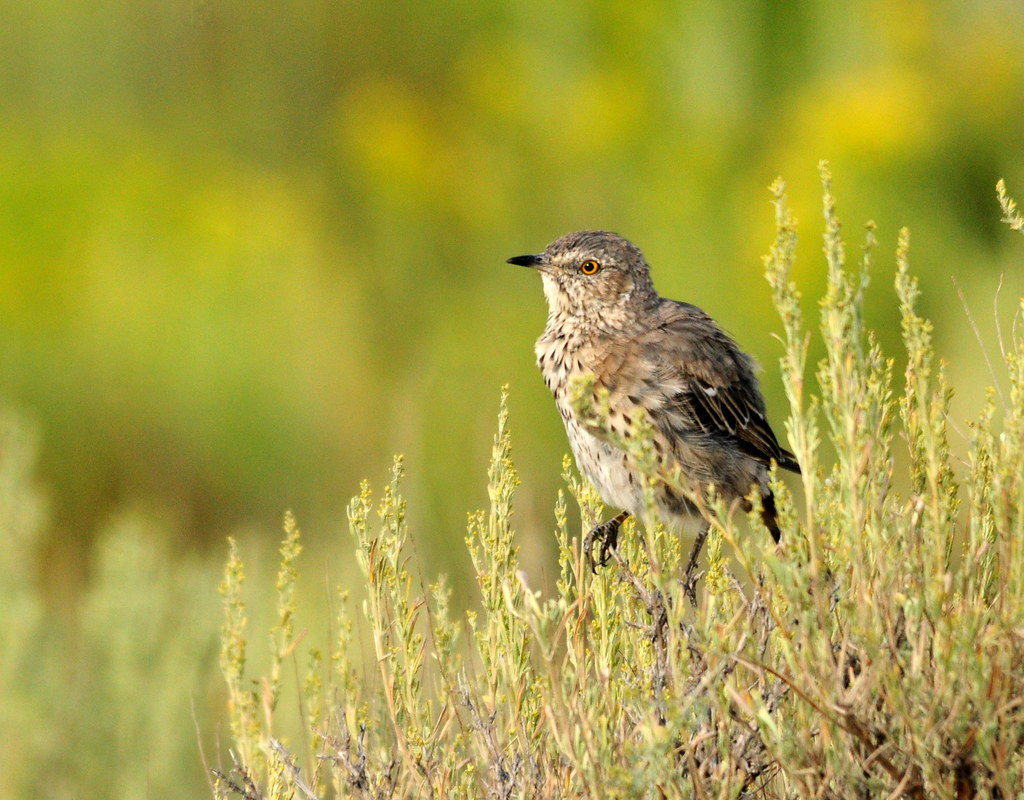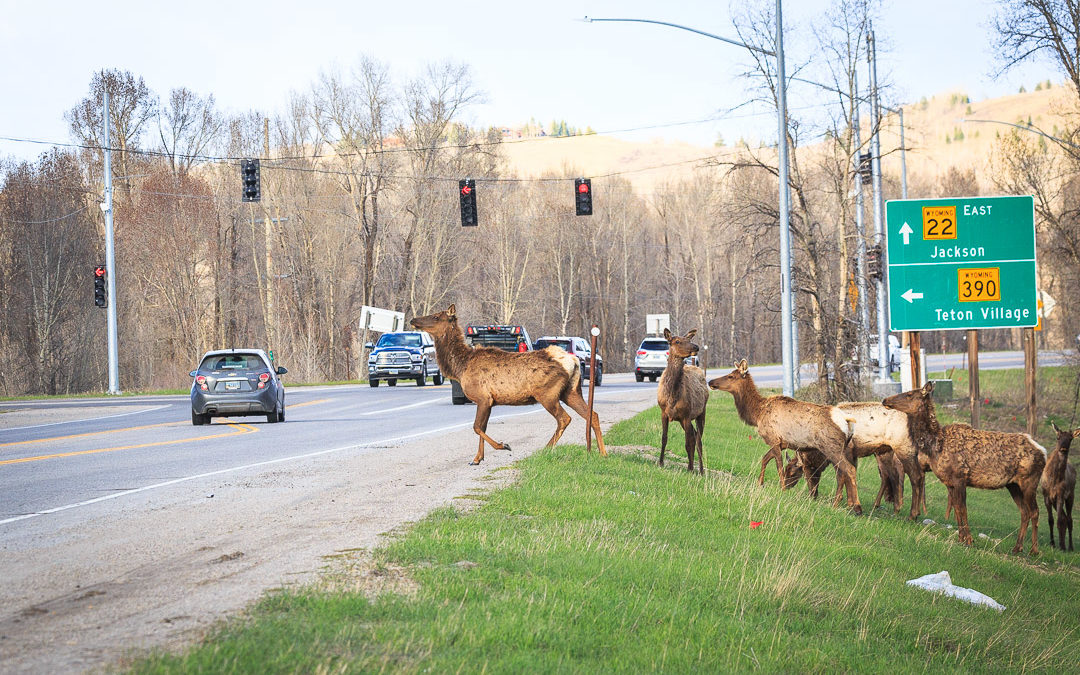
by jhwildlife | Jun 6, 2019 | Blog
by Jon Mobeck, Executive Director
“Preserve and protect the area’s ecosystem in order to ensure a healthy environment, community and economy for current and future generations.” – Teton County Comprehensive Plan’s Vision Statement, adopted 2012
In July 2019, the Jackson Town Council and Teton County Board of County Commissioners voted to add to a November, Specific Purpose Excise Tax (SPET) ballot measure that will allocate (if voters approve) $10M for wildlife crossing solutions at sites prioritized within the County’s Wildlife Crossings Master Plan.
While there are many worthwhile and necessary projects on the slate, we believe that wildlife crossing solutions address the vision of our Comprehensive Plan (quoted above) precisely, warranting commensurate investment. Oddly, and despite the fact that the community has repeatedly stated that wildlife is a paramount value, the community has had very few opportunities to voluntarily invest in the preservation of wildlife or our ecosystem. In the case of the SPET, the burden of that investment is shared by both local residents and tourists. That cost-share for the benefit of wildlife makes sense, since our local economy rests on the health of a globally significant ecosystem that requires wide-ranging stewardship.
What about the question of “how much?” While we intuitively value “saved wildlife,” safer highways and connected habitats, those intangible benefits are difficult to measure. Most cost-benefit analyses look at the tangible costs of wildlife-vehicle collisions (WVC) to ungulates (many other small and large animals are hit by cars in our valley, including hawks, eagles, owls and osprey). Those costs include vehicle damages, bodily injury, carcass removal/disposal and the “game value” of the animal as assigned by the Wyoming Game & Fish Department. The “wildlife-vehicle collision costs per species” varies from state to state, but for our purposes in Wyoming, we estimate those costs as follows:
Moose = $51,500
Elk = $31,000
Deer = $15,600
The differences in these costs correlates to the size of the animal and the related severity of a collision. To analyze the efficacy of wildlife crossing structures at these specific prioritized sites, we project the current 5-year WVC trends (from the Teton County Wildlife-Vehicle Collision Database that we manage) into the future and assign a WVC Cost Per Species as listed above. We then calculate the cost saved through estimated WVCs reduced. None of these numbers reflect the value of moose, elk or deer to our tourism economy, nor do they reflect the value of the animal within our particular ecosystem or community. Jackson Hole values moose and elk extremely highly, partly due to their intensely-monitored populations, but also because they are iconic symbols of this wild place, and veritable neighbors to many around the valley.
Wildlife crossing structures have been shown to reduce ungulate WVCs by 80-90% when appropriately fenced, but they are not the only or best solution everywhere. In some cases, the geologic/geographic/hydrologic properties of a location preclude effective structural solutions. In other places – especially roadways of 40 mph or lower – a variety of tools can be deployed to positively affect WVC-reduction at a good “cost-per WVC reduced.” Those tools are being used in the town of Jackson, along the WY390 route, and soon in the town of Wilson to slow drivers and increase the probability of avoiding collisions with animals. We use the same cost-benefit formula to assess the efficacy of any tool deployed in any location, enabling the best solutions based on the variables present at each site.
We feel that the four “top priorities” considered within this measure are best addressed with structural solutions. The spreadsheet below includes WVC projections and the economic value of WVC costs saved over 20-year intervals at five prioritized locations (WY390/WY22 intersection, WY22/Bar Y, WY189/WY181 Camp Creek/Hoback, WY22 Teton Pass West MM 14-17, and West Broadway in the town of Jackson – the non-structural solution in this mix). These numbers do not incorporate inflation, and while they are estimates based on current trends in each location, the extrapolated numbers (rounded for simplicity) do not consider changing population or distribution dynamics over time, which is likely to occur to some degree. Each site was analyzed as a two-mile stretch of highway, with the exception of West Broadway, which is a one-mile site. Click on the spreadsheet below to enlarge.

What we find is that appropriate mitigation measures installed at these 5 sites should pay for itself in WVC cost savings in about 20 years, and perhaps less. While appropriate mitigation measures at all sites will likely exceed $10 million dollars, if we conservatively assume that the measures we can take in these 5 locations will ultimately reduce current WVCs by 70% (recognizing some limitations in a few of these sites), we would save just over $15M in 20 years. After that 20-year period, future savings (an additional $31M over the ensuing 40 years of a structure’s expected 75-year lifespan) exceed the cost of the solutions implemented. That is a good use of public money, especially when considering that this public money is invested expressly to realize the vision of the County’s Comprehensive Plan. We aim to be conservative in our estimates as we place a high value on the efficient use of public funds.
![]() I hope that you will agree with Jackson Hole Wildlife Foundation, Greater Yellowstone Coalition, Jackson Hole Conservation Alliance and countless other community members that a $10M SPET investment in solutions for these sites is an extremely prudent investment for our community. It’s not always easy to measure the value of a publicly-funded item, but in this case, we can make an easy economic case for the value of our foresighted action. These actions, combined with other site-specific solutions elsewhere, will make our highway network safer for drivers and wildlife.
I hope that you will agree with Jackson Hole Wildlife Foundation, Greater Yellowstone Coalition, Jackson Hole Conservation Alliance and countless other community members that a $10M SPET investment in solutions for these sites is an extremely prudent investment for our community. It’s not always easy to measure the value of a publicly-funded item, but in this case, we can make an easy economic case for the value of our foresighted action. These actions, combined with other site-specific solutions elsewhere, will make our highway network safer for drivers and wildlife.
To learn more about WVC solution opportunities at many of the County’s prioritized sites, please review this Wildlife Crossings Master Plan Action Summary to which Jackson Hole Wildlife Foundation contributed.
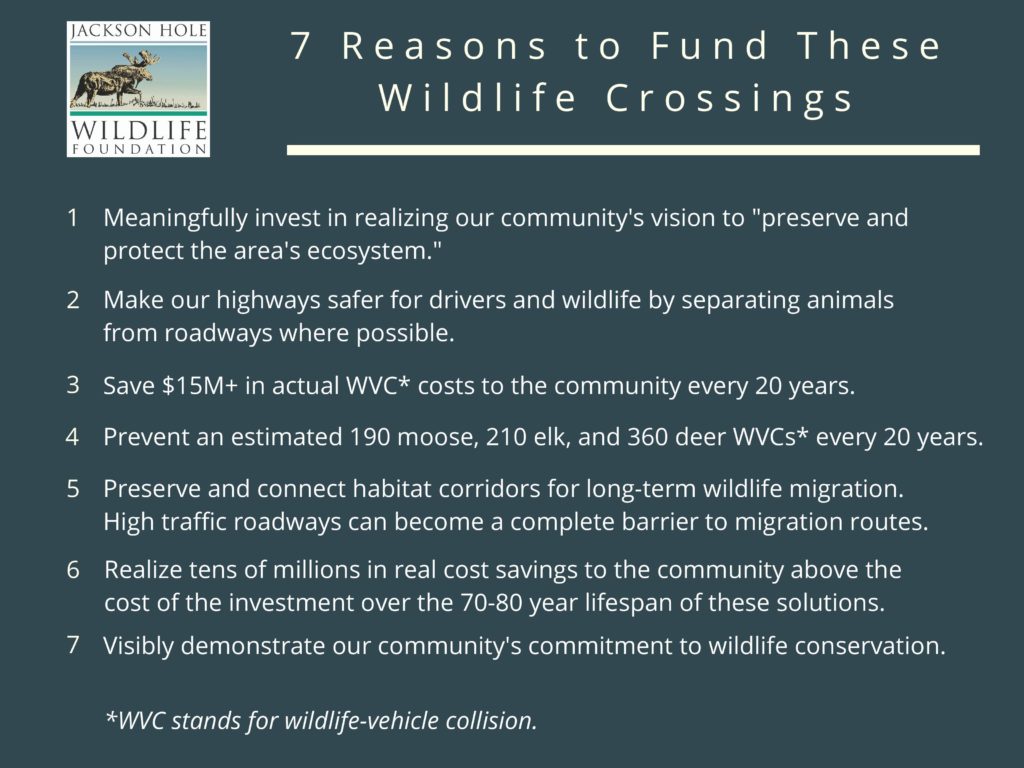
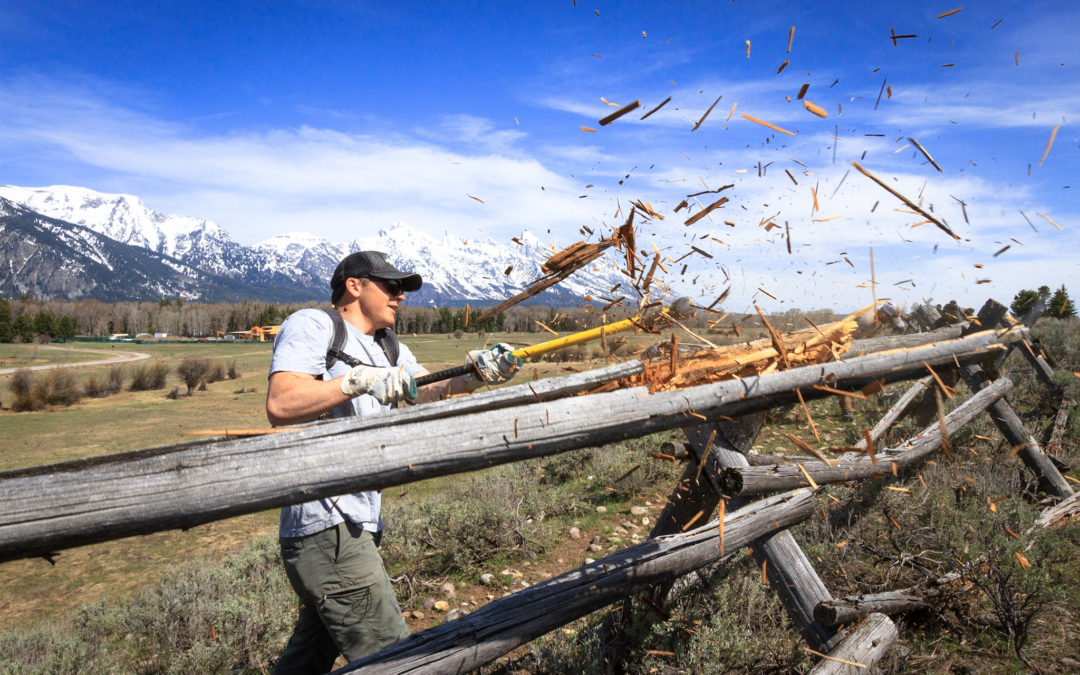
by jhwildlife | May 23, 2019 | Blog
Guest Blog by Josh Metten | Senior Naturalist, Jackson Hole Ecotours
“Look! There’s a herd in the pasture over there!” I point out a herd of elk to my group of students and their parents from Grace Episcopal School in Monroe, Louisiana. Unlike a normal EcoTour of Grand Teton or Yellowstone National Parks, we’re on private land in the Snake River Bottom. It’s day three of our tour, and today we’re working with the Jackson Hole Land Trust and the Jackson Hole Wildlife Foundation to remove fencing which has been impeding the movements of the very herd of elk we’re now looking at.
It’s our third year of fence removal stewardship with Grace and the JHWF. The first year we busted buckrail in an elk calving area within Grand Teton National Park. The next year we coiled old barbed wire on public land south of Jackson, watching later as a mule deer doe walked through our handiwork. But this year we’re doing something different, working with the JHLT, JHWF, and private landowners to help steward core riverbottom habitat. It’s an area we would not otherwise be allowed to venture, but our benefactors, the elk, know nothing of property rights.
Saving Wyoming’s Great Migrations
Despite this week’s spring snowstorms, the green wave is now racing across the Wyoming landscape. Fresh grasses and flowers are bursting from the moist soils, to the delight of our elk, mule deer, pronghorn antelope and other ungulate herds. These species all share a key adaptation in common, they migrate to survive the harsh Wyoming Landscape.
These migrations, many of which are thousands of years old, take herds across busy highways, where they risk collisions with speeding cars. They cross property boundaries, jumping over barbed wire or buckrail fences, some are injured or even killed in the process.
Why go through all the trouble? Research with GPS collars has shown that migrating animals are able to stay with spring longer, taking advantage of the most fertile period of plant growth for an extended period. This strategy only works however, if the habitat remains protected and the animals can effectively travel their migration routes.
Stewardship in Action with the JH Wildlife Foundation and JH Land Trust
Look across the Jackson Hole valley and much of what you see is now protected public land. With the creation of the National Elk Refuge in 1912, and expansion of Grand Teton National Park in 1950, ancient migration routes, were protected, but hundreds of miles of fencing from old ranching operations remained.
Over the last 20 years the Jackson Hole Wildlife Foundation and an army of volunteers have worked to remove or modify this fencing, rewilding the National Park. The remaining lands, about 3% of Teton County, are private, and lay primarily along the riparian corridor of the Snake River. The cottonwood galleries, creeks, ponds, and spruce/fir forests found here offer disproportionately rich habitat for wildlife. As such they are of critical conservation concern.
That’s why the Jackson Hole Land Trust has worked with landowners to conserve over 55,000 acres of private lands using conservation easements, which preserve the conservation values of the land in perpetuity. The parcel we’re at on this sunny Mother’s Day weekend is one such easement, an agreement patiently brokered by the JHLT and three separate landowners.
Don’t Fence Me In: Boots on the Ground Conservation
After a quick orientation from Erica at the JHLT, Gretchen Plender and Jon Mobeck of the JHWF, we set off to remove old buckrail fence at the top of a ridgeline which overlooks the river corridor. The weathered fencing already has some gaps, and Jon shows us the packed dirt trails of hundreds of elk who have passed through these limited openings.
“We’re going to create more openings by removing this old fence so the herds can move more freely.” he tells us. With mini sledge hammers and fencing tools the students, recent 8th grade graduates, tear into the fencing. Post by post quickly drop as the mile long section begins to vanish into the sagebrush.
Studies show that in the Western U.S. one ungulate per year dies from entanglement in fencing for every two miles. Young calves who become separated from their mothers by fencing can double this statistic. With the fencing in this section removed elk migrating to the river from winter habitat on the National Elk Refuge now have a clean route through a historically challenging corridor.
We finish for the day having removed over half of the section, the rest of the EcoTour Adventures team will return tomorrow, Mothers Day, to complete the job. It’s a fitting time to do fence work for wildlife. We pass a herd of cow elk beneath the cottonwoods as we depart, most of which are likely pregnant. In a few weeks these forests will become a nursery for hundreds of newborn calves. They will quickly grow through the summer months, and when the first snows come in the fall the calves will follow their mothers out of the river bottom. They will pass by remnants of fencing, unaware of what formerly stood in their path.
What you can do to Conserve Wyoming’s Wildlife
Want to help wildlife in Jackson Hole and across Wyoming this summer? We’ve got a few ideas for you:
Public Fence Pull Projects with the JHWF: Join the Jackson Hole Wildlife Foundation for boots on the ground conservation removing or modifying fencing to facilitate wildlife passage. Dates are listed here: https://jhwildlife.org/our-work/current-projects/
Contact: kyle@jhwildlife.org
Buy a Wildlife Conservation License Plate: Wyoming Residents! We invite you to join Jackson Hole EcoTour Adventures and many of our guides in purchasing a Wildlife Conservation License Plate. Proceeds from these plates directly fund wildlife crossings and other mitigation strategies to reduce car collisions with wildlife. It’s a win win for wildlife and people. http://www.dot.state.wy.us/wildlife_plate
Now in our 11th year of operation, Jackson Hole Ecotour Adventures leads half day, full day, and multi day wildlife, cross country ski, and snowshoe tours in Grand Teton and Yellowstone National Parks 365 days a year. Let us help maximize your Jackson Hole Experience Today! 307-690-9533 or info@jhecotouradventures.com
Josh Metten is a Senior Naturalist with Jackson Hole EcoTour Adventures with nearly a decade of experience guiding and sharing stories about the Greater Yellowstone Ecosystem.
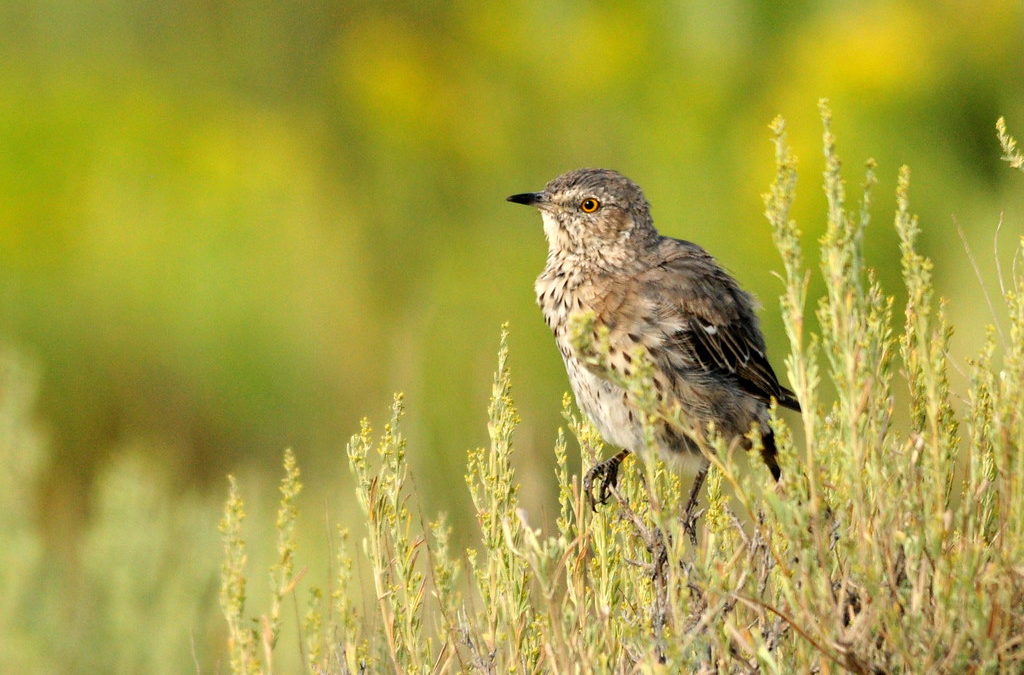
by jhwildlife | May 17, 2019 | Blog
As the sun warms in mid-May, the aroma of sagebrush fills the valley once again. Sage-grouse leks are quieting down, bird migrants are staking out territories, and resident mammals are shifting their habitats. Nature mappers can see and hear a good number of species specialized to the sagebrush-steppe by taking a drive through the “flats” of Grand Teton National Park.
Many species depend upon the expansive sage-dominated habitat that covers much of the valley floor. Mountain Sagebrush is adapted to the well-drained glacial soils and provides shelter, food, and breeding sites. Greater Sage-grouse, Brewer’s Sparrow, and pronghorn require sagebrush and are deemed “obligates”. For others it is not essential but preferred habitat here in Jackson Hole. Savannah and Vesper Sparrows, Western Meadowlarks, Sage Thrashers, and Green-tailed Towhees build nests in the dense shrubs and search for insects and spiders for food. Red-tailed Hawks and Northern Harriers hunt for rodents, such as least chipmunks, Uinta ground squirrels, and voles. Hummingbirds zoom in to pollinate larkspurs and scarlet gilia.
The next few weeks is a great time to see and nature map wildlife. Songbirds are singing atop sagebrush to establish territories and attract mates. You may see males fly at intruders or observe courtship behaviors – bowing, feeding, and fluttering. Later on, most birds go quiet while raising chicks and so are much harder to find.
Mammals are also active. Pronghorn arrive just about now and soon will be giving birth. Coyotes will be looking for fawns hidden among the sage shrubs, although ground squirrels are much easier to catch. “Red” bison calves will be cavorting, and mule deer are moving about belching out volatiles of their favored forage: sagebrush. The smell of sagebrush leaves comes from terpenoids and coumarins, which serve as chemical defenses. Wildflowers begin blooming in abundance in June – paintbrush, hawksbeards, sulphur buckwheat, lupine, and balsamroot, adding to the splendor of the scene.
So take an early morning or evening drive through the park – around Antelope Flats, up the park road. Or better yet, find a spot to sit quietly with your binoculars and a spotting scope handy. And please, keep on nature mapping. We want to be sure our common sagebrush-steppe species stay common. Your observations help us know how these critters are faring over time.
Thank you!
Frances Clark, Nature Mapping Volunteer

Pronghorn are an iconic species of the sagebrush-steppe. Photo: Mark Gocke.

by jhwildlife | May 2, 2019 | Blog
The Jackson Hole Wildlife Foundation is excited to introduce our two, new seasonal passerine bird banders! Dakota Vaccaro and Vicki Morgan will be joining our team this summer and will be tasked with leading our Monitoring Avian Productivity and Survivorship (MAPS) stations and with banding nestling and adult Mountain Bluebirds in Grand Teton National Park and the National Elk Refuge. Both have extensive backgrounds in avian research across the Country, and we feel lucky to have them on board. Please join us in welcoming them both to our organization and to the Jackson community. Don’t hesitate to introduce yourself this summer if you run into them on a JHWF project or out on the trails!
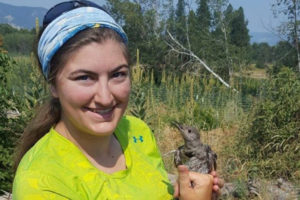
Dakota Vaccaro with a Northern Flicker
Dakota Vaccaro recently graduated from University of Montana with a B.S in wildlife biology and minor in ecological restoration. She has always been fascinated with wildlife and was inspired by her ornithologist grandmother to follow in her footsteps. Her prior work experience encompassed a wide variety of wildlife jobs and research projects, from studying sharp-tailed grouse for Colorado Parks and Wildlife, to running bird banding stations for the University of Montana bird ecology lab. For the last two years, Dakota has been conducting her own original research on the impacts of wildfire on wildlife occupancy. She is a huge advocate for increased environmental education and has even taught multiple survival and nature camps/classes to youth of all ages. In her spare time, Dakota enjoys hiking, photography and birding.
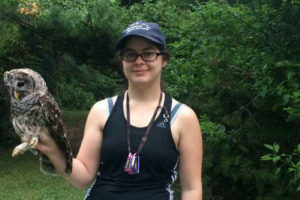
Vicki Moran with a Barred Owl
After graduating from the University of North Carolina at Asheville with a B.S. in Ecology and Evolutionary Biology, Vicki Morgan has been working as a roaming biologist and bird bander across the United States. Her past wildlife-related jobs were in areas such as South Carolina, Illinois, American Samoa, Washington DC, NYC, Maryland, and Montana, where she studied and banded birds ranging from hummingbirds to hawks. Vicki has been an avid birder from a young age, and she also enjoys expressing her love of nature through art (fun fact: Vicki actually Minored in ceramics). While in Jackson, she is hoping to explore the Tetons and learn more about the local birds.
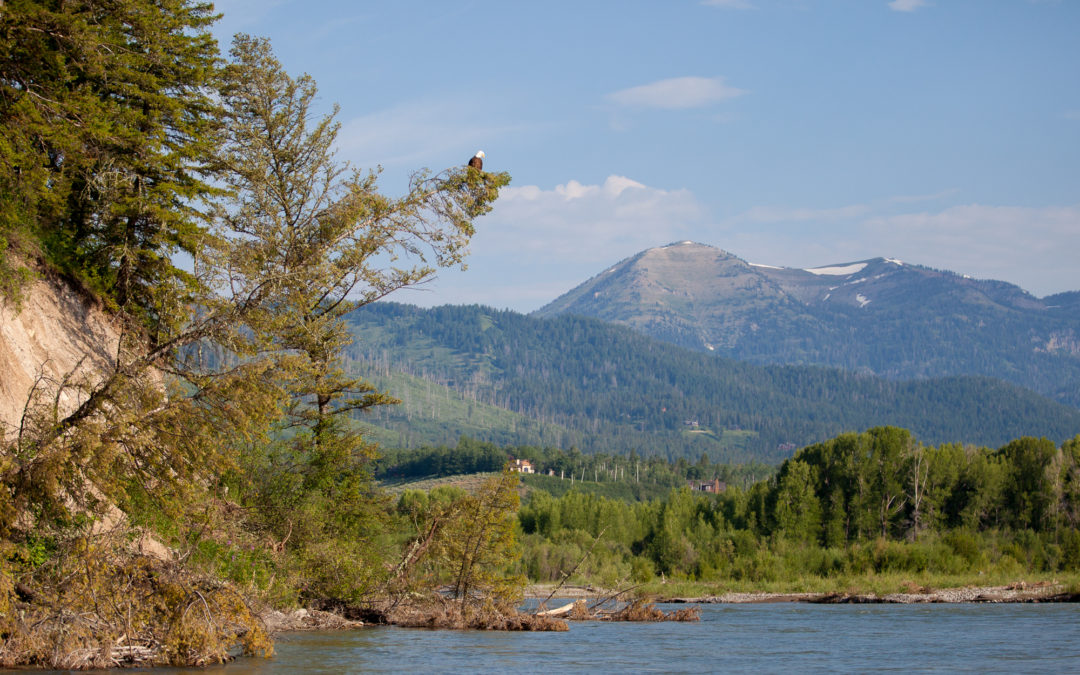
by jhwildlife | Apr 16, 2019 | Blog
by Kyle Kissock, JHWF Communications Manager
Beginning May 5th, we invite you to kick-off your Sunday mornings with guided wildlife-watching adventures on the Snake River!
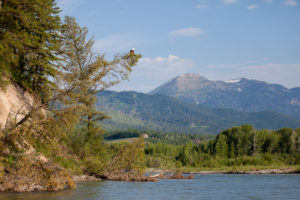
Bald Eagles are common sightings on Snake River Float Trips
Veterans and newcomers alike are welcome to join us for the 10th season of Nature Mapping Snake River Float Trips with program partner AJ DeRosa’s Jackson Hole Vintage Adventures. Float trips cost $30 and embark from the Wilson Bridge every Sunday morning through early October.
These scientific voyages help gain a better idea of what species of mammals, birds and amphibians utilize this eight mile section of river. They are also fun opportunities to connect with others from the Nature Mapping community, while learning a bit more about local ecology and wildlife identification along the way.
Why have we been asking you to help us collect data along the Snake River for 10 years?

Teton County Habitat Value Map. Areas in green represent “high value” while yellow represents “intermediate” and red represents “low value”.
For starters, if you look at the Teton County Habitat Map, you’ll notice Teton County has labeled nearly all of the habitat along the Snake River green, meaning “high value” for wildlife. You’ll also notice most of what is considered “high value” is riparian habitat; rivers, lakes, streams, and adjacent vegetation. Riparian habitat is relatively scare in Wyoming; it only comprises 1.2 % of Wyoming’s total surface area (for comparison, sagebrush dominated ecosystems are estimated to cover as much as 60% of Wyoming’s landscape). Yet a majority of the state’s animal species rely on it at some point during their life cycles, making healthy riparian zones (like the Snake River bottom) disproportionately important to maintaining healthy wildlife populations.
Floating the river at regular intervals for a decade has provided Nature Mapping Jackson Hole with a long term data set we can provide to scientists (like those involved with the construction and maintenance of the levee system) to gauge the health of the Snake River in our area. This is especially important because the stretch we float, flows mostly through private land where wildlife managers do not regularly conduct systematic censuses.
We can also begin to explore trends in the data ourselves. For instance, we’ve seen a decrease in beaver and otter sightings over the course of our float surveys. Are we noticing a decline related to what has been observed in Grand Teton National Park, where beaver populations have decreased by up to 80% over the last 40 years? On the other hand, sightings of Bald Eagles have increased each year since 2015. Last year, we set a record with 222 Bald Eagle observations (average 12 per trip), which trumped the previous record set in 2017, of 171 (average 8 per trip). Along with Bald Eagles, observations of Canada Geese, Spotted Sandpipers, and Common Mergansers have all been on the rise each of the last four years.

View of the Snake River looking south off the port side bow.
Lead volunteer Tim Griffith generously compiles a full report of our observations at the end of each float season. You can read Tim’s full 2018 report here. You can also check out previous years of data here and let us know if you can identify any wildlife trends on your own!
Our Bald Eagle data is also a great example of how we should be careful when making conclusions from our float data. For instance, each of the last three years our Bald Eagle sightings have peaked in mid-August, which also happens to be when river flow (or discharge) is at .or near its weakest. One might conclude that the low-water means easier fishing and scavenging for the eagles, and that Nature Mappers have discovered that this is the time a birder is mostly likely to encounter an eagle on the Snake River. But perhaps less discharge simply means a slower float, and thus more time for Nature Mappers to sight eagles from the boat?
Flow rate of the river is one of many hidden variables that we should be aware of when we make data comparisons. Everything from shifting river channels to the skill and number of nature mappers on board can influence what we observe. What we can say for sure, is that float data shows presence (not absence) of wildlife species. Our data is still extremely helpful in understanding what creatures are utilizing the Snake River corridor and potential timing of usage, such as when birds are migrating, and if timing of migrations is changing. Thanks to the number of variables at play, Snake River Float Trips are a fascinating study in how complicated getting a full understanding of an ecosystem can be!
If you’d like to sign up for this year’s floats you can contact us at info@jhwildlife.org or Tim Griffith at timgrif396@gmail.com. Trips depart from the Wilson Boat ramp early, Sunday mornings. No prior boating experience is needed.
We hope you’ll join us on the water!
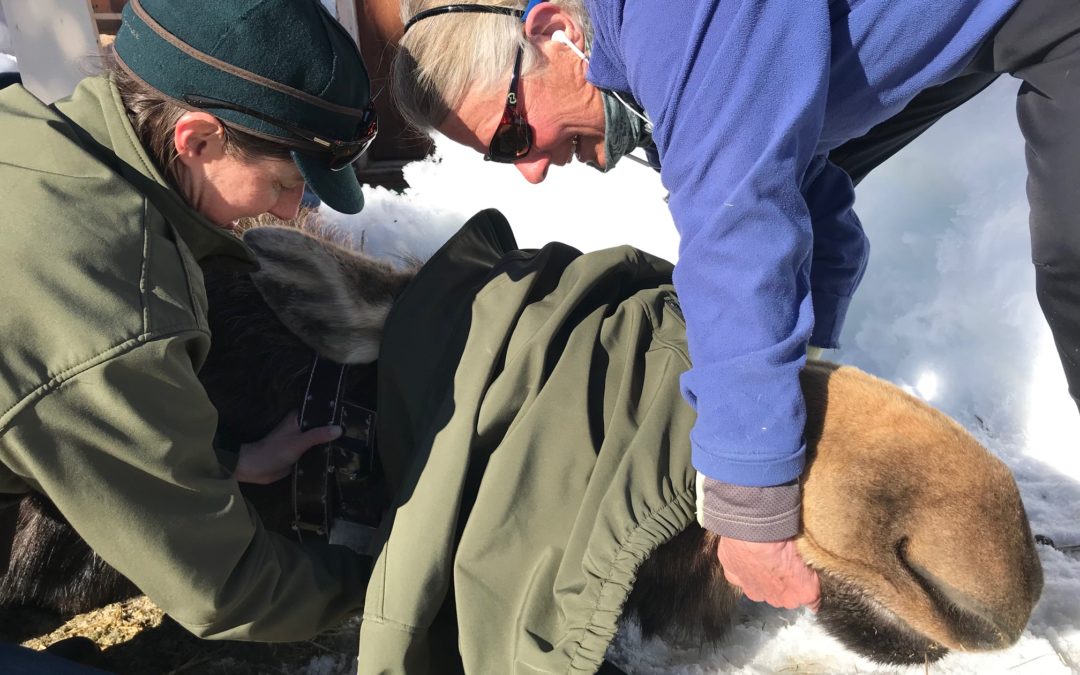
by jhwildlife | Mar 21, 2019 | Blog
Kyle Kissock – Communications Manager
Next time you see a moose along the Moose-Wilson Road, you might notice it sporting something a little different…
Starting this week, the Wyoming Game and Fish Department is fitting ten moose with GPS tracking collars in the vicinity of the Highway 22/390 intersection. The collars have been provided by the Wyoming Department of Transportation, and the goal of collaring moose in this location is to better understand movement patterns in this critical habitat zone. The movement patterns will guide where wildlife underpasses may be installed, in conjunction with the Snake River Bridge replacement project (scheduled for 2022).
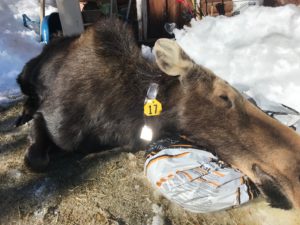
In this picture, the soil bag keeps the moose’s head tilted to ensure it’s airway remains clear. We constantly monitored this moose while it was sedated.
Wondering what goes into putting a tracking collar on a live moose? I was lucky enough to tag along and find out how biologists safely collar moose in the field!
It starts with selecting the right moose. As we know, this winter has been hard on ungulates in our valley. Although this process is generally safe for the moose, biologists want to avoid putting undo stress onto already taxed animals, so they will be looking for healthy individuals who are at least yearlings in age; calves are not collared. This project is also specific to the “West Bank” of the Snake River and biologists are only searching for animals which inhabit the Moose-Wilson Road corridor.
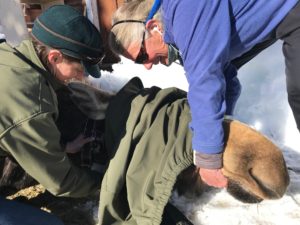
Using a coat as a blindfold helps protect the animal’s eyes as the biologist takes a blood sample to identify possible diseases. This moose even got an anti-tick medicine!
We ended up locating a cow- yearling pair who were well-nourished and showed minimal signs of hair loss or disease…perfect candidates for GPS collars.
The darting and collaring process was surprisingly quick, given the size and strength of the animals involved. After the moose were darted in the rumps, where their biggest muscle groups are, it took about 10 minutes for the tranquilizers to take effect. Like humans, drugs effect each critter differently, but these animals went down relatively easily, first to their knees, then bellies to the earth. We approached the moose and made sure they were not lying in positions where the ground could put pressure on their airways; suffocation was the biggest hazard for the sleeping duo, but one that could be easily mitigated. Fun fact: moose aren’t quiet sleepers, they actually snore and drool a little while they snooze!
While a small group of volunteers held the animals’ massive heads to make sure they kept breathing, the biologists drew blood samples to test for diseases and to see if the adult female was pregnant. Generally, a pregnant population of moose is a good indicator the population as a whole is doing ok. The adult female was given antibiotics for a small wound we discovered while collaring her, and even some tick medicine, which as a wild animal is likely as close as she will ever come to getting a veterinarian’s check-up!
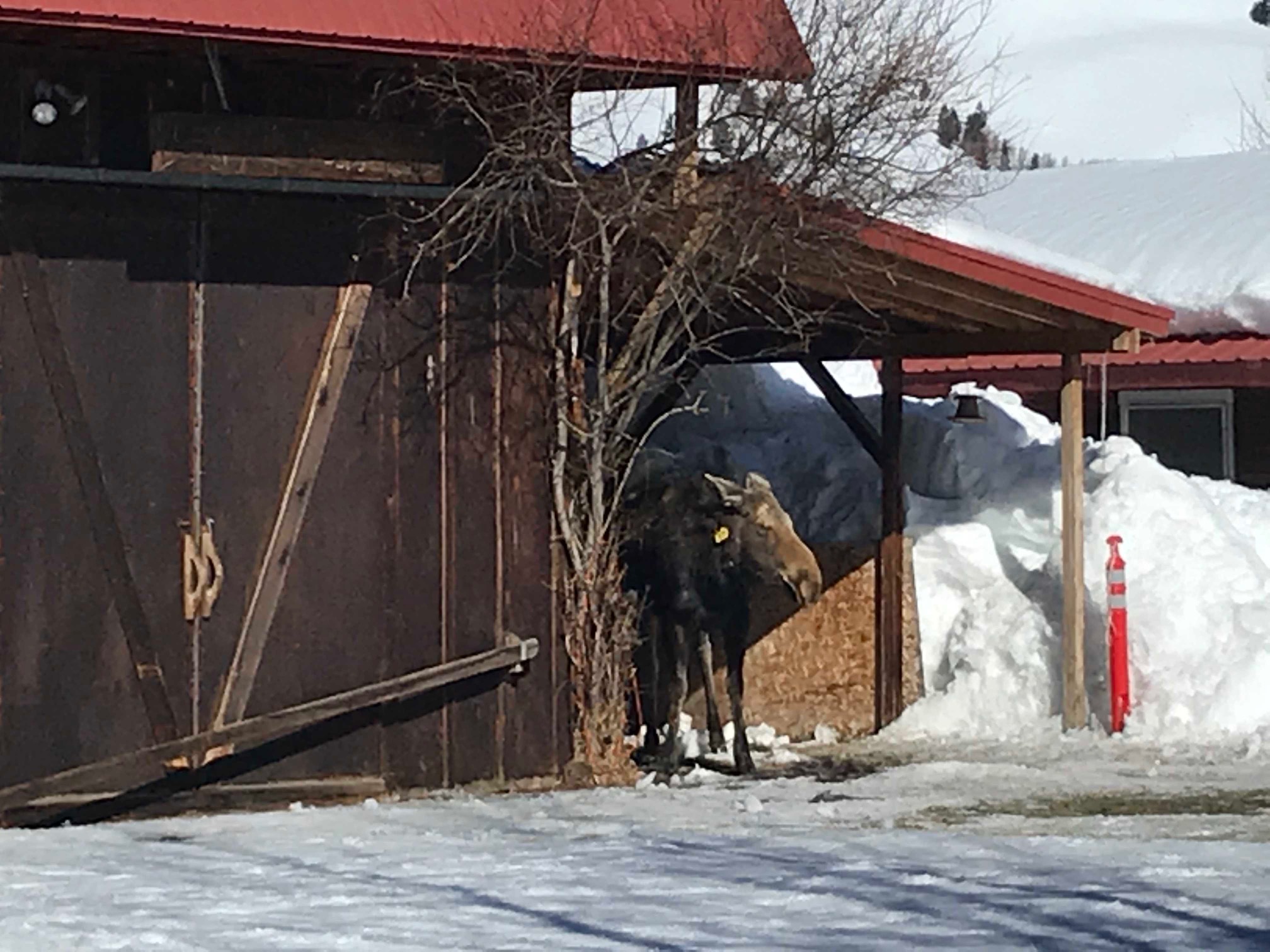
The “after” photo, showing the yearling, a little woozy, but happy and healthy with the newly fitted GPS collar and tag. This first thing she did after waking up? Started munching on willows of course!
The next step is fitting and applying the GPS collars. We get questions from time to time about whether the collars will impact the quality of life for the moose (which is a great question). The collars are designed to not encumber the movements of the animal and will actually release, usually after a few years, when sufficient data is acquired. The biologists will then be able to track and recover the dropped collars. While the moose might prefer not to be wearing a necklace, scientists don’t believe these collars negatively influence their lives in any way. In fact, when these two woke up, they seemed utterly unaware anything had changed.
Before the moose were released, biologists injected each animal with a “reversal drug” which kicked in in a matter of minutes. The idea was to limit the time the animals were sedated in order to create as little stress for them possible. This brought both of the moose out of their slumbers, a little dazed, but no worse for the wear.
This project is the first time scientists have collected movement data on this population of “West Bank” moose. In addition to guiding underpass construction, it will also be interesting to find out whether or not these animals are migratory, and if there are specific times of day and certain locations where they are choosing to cross dangerous roads. We will report back when the data starts to come in, so stay tuned!
And when you do see a moose with a collar and a yellow tag, you can be sure that moose is providing important data for a good cause. And continue to drive cautiously, especially on Highways 22 and on 390 at night!

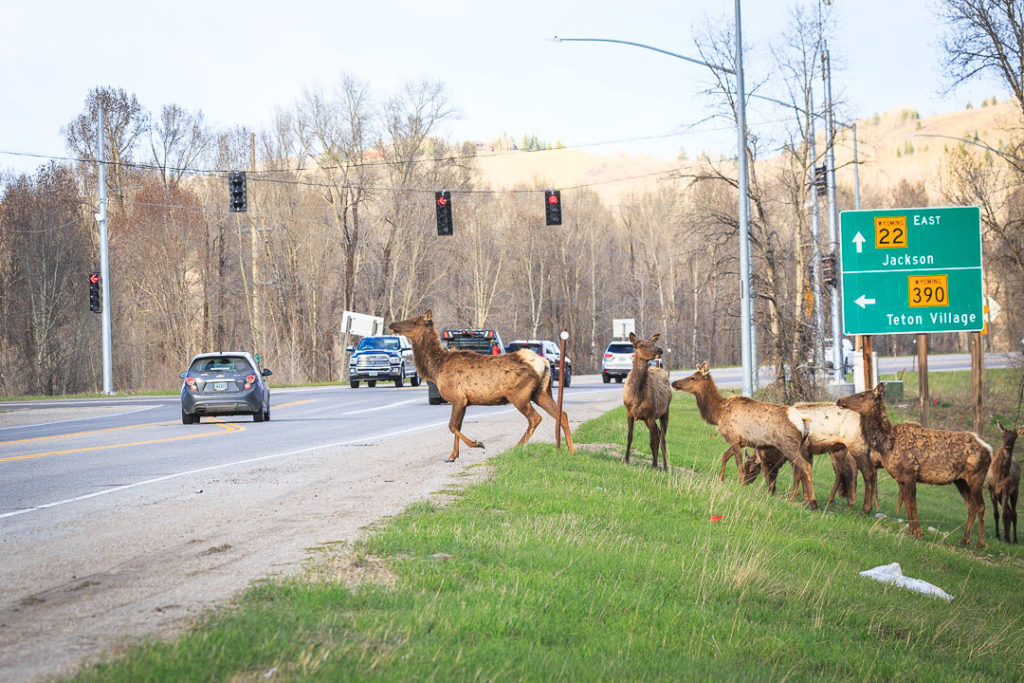
I hope that you will agree with Jackson Hole Wildlife Foundation, Greater Yellowstone Coalition, Jackson Hole Conservation Alliance and countless other community members that a $10M SPET investment in solutions for these sites is an extremely prudent investment for our community. It’s not always easy to measure the value of a publicly-funded item, but in this case, we can make an easy economic case for the value of our foresighted action. These actions, combined with other site-specific solutions elsewhere, will make our highway network safer for drivers and wildlife.





